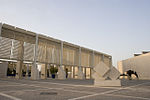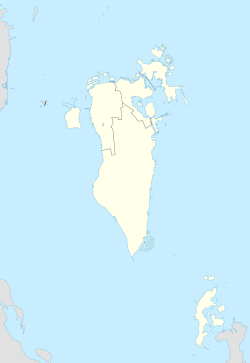
Back Al-Manamah ACE Manama Afrikaans Manama ALS ማናማ Amharic Manama AN Manama ANG المنامة Arabic المنامه ARZ Manama AST Manama Azerbaijani
Manama
الْمَنَامَة | |
|---|---|
Clockwise from top: Bahrain World Trade Center; skyline with roads, towers and harbour of Manama; night view of Manama City; and Manama City view | |
| Coordinates: 26°13′24″N 50°35′15″E / 26.22333°N 50.58750°E | |
| Country | |
| Governorate | Capital |
| Government | |
| • Governor | Hamad bin Isa Al Khalifa |
| Area | |
| 30 km2 (10 sq mi) | |
| Population | |
• Estimate (2012) | 297,502 |
| • Density | 5,200/km2 (13,000/sq mi) |
| • Urban (2020)[1] | 635,000 |
| • Capital Governorate (2020) | 534,939 |
| Time zone | GMT+3 |
| Block number | 3XX–4XX |
| Website | capital |
Manama (Arabic: الْمَنَامَة el-Menâme, Bahrani pronunciation: [elmɐˈnɑːmɐ]) is the capital and largest city of Bahrain, with an approximate population of 297,502 as of 2012. Long an important trading center in the Persian Gulf, Manama is home to a very diverse population. After periods of Portuguese and Persian control and a short invasion from the ruling dynasty of Saudi Arabia, followed by a longer invasion by Oman, Bahrain established itself as an independent nation in 1971 following a period of British hegemony.
Although the current twin cities of Manama and Muharraq appear to have been founded simultaneously in the 1800s,[2] Muharraq took prominence due to its defensive location and was thus the capital of Bahrain until 1923. Manama became the mercantile capital and was the gateway to the main Bahrain Island.[3] In the 20th century, Bahrain's oil wealth helped spur fast growth and in the 1990s a concerted diversification effort led to expansion in other industries and helped transform Manama into an important financial hub in the Middle East. Manama was designated as the 2012 capital of Arab culture by the Arab League, and a beta global city by the Globalization and World Cities Research Network in 2018.[4][5]
- ^ Annual Population of Urban Agglomerations with 300,000 Inhabitants or More in 2014, by Country, 1950–2030 (thousands), World Urbanization Prospects, the 2014 revision Archived 18 February 2015 at the Wayback Machine, Population Division of the United Nations Department of Economic and Social Affairs. Note: List based on estimates for 2015, from 2014. Retrieved 11 February 2017.
- ^ Ben Hamouche 2008, p. 185.
- ^ Ben Hamouche 2008, p. 186.
- ^ Manama Capital of Arab Culture 2012
- ^ "Ministry of Culture: Manama as the Bahraini Capital of Arab Culture". Archived from the original on 11 September 2014. Retrieved 9 October 2014.







